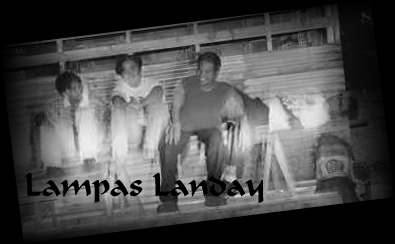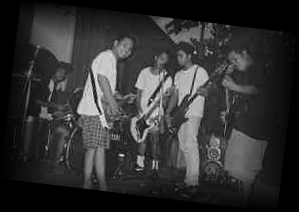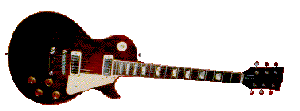- Lampas Landay Blasts into Guam's Music
-
- Manila Manila Magazine, Sining at Kultura (April 1997 issue, page 10)
- Lampas Landay Album Review by Jerry Portodo
-
-
- " The kids are alright," Pete Townshen of the Who wrote and titled one of The Who's albums in the late 70's when the
most sickening phase of the disco muzak era was at its height and there seemed no future for rock.
-
- Townshend, one of the true keepers of the rock and roll flame, was of course referring to the emergence of the punk and new wave
movement which brought back the originality, spunk, and energy back into rock at a time when the old guards had lost their edge and
were too engrossed with making millions in their "arena rock" concerts.
-
- Townshend's comment is the first thing that comes to mind upon hearing the initial offering of a new band called Lampas Landay
(meaning beyond shallowness in Tagalog) which is now available at Johndel Supermart. The name that the group chose is itself
indicative, reflecting the members, view of the alternative music scene on Guam today --- a scene where there's no real venue where
the tribes could gather and good bands have metamorphosed into showbands, playing cha-cha at the drop of a hat to please a not
too discriminating clientele.
-
- It was into this milieu that the young members of Lampas Landay burst into. Bong Redila (guitar/vocals), Gilbert Redila
(guitar/vocals), Jerome Magdaluyo (bass), and Arden Bonto (drums/vocals) are all relatively new to Guam, having lived their
formative teen years in the Philippines and left the country just when the alternative music scene there was beginning to explode to
what it is today. Expecting the pulsating music scene of the states, the four were disappointed with what they found here so when
they met each other throught a mutual friend (Jun Barazon) and discovered that they shared similar musical interests, the forming of
Lampas Landay became inevitable.
-
- Although young and belonging to the Gen X generation, the members of Lampas Landay certainly know their rock history. And this
shows in their songs which have influences from the 60's, 70's, 80's and 90's. The range of influences is very eclectic... from Velvet
underground, the Doors, the Beatles, Jesus and Mary Chain, to New Order, The cure, and Sonic Youth.
-
- In their songs, there is a freshness and touching innocence which can easily be discrened. These, after all, are youths barely out of
their teens, and like all young people throught the ages, they sing about youthful angst like falling in love, falling out of love, and the
yearning for the simple joys of childhood. But there is also sharpness, anger, and urgency as when the group sings about being
"Mga banyaga sa bangketa" and nights "na hindi mo alam kung saan ka tutungo."
-
-
- The album opens with Soft Petal of Cordoba, a tender love song done acoustic style about the innocence of first love (... I left all my
sadness to the sun, I close my eyes with smile, and chose the one) and the pain of rejection (... chose the one, never thought my
gloomy days just begun... left all my sadness to the sun...gray skies cried sorrows undone...)
-
- One of the Tagalog songs is Banyaga sa Bangketa (Foreigner in the Sidewalk) where the band sings about what it is like to be in a
foreign land. It is also a reminder to Filipinos in the motherland that expatriate Filipinos are still true Filipinos at heart (ginoo 'wag mo
na kaming gitlain o maliwin niring limim/magiliw pa rin sa amin ang dilim). Despite angst, this is a happy song, with a catchy and
uptempo beat reinforced by the additional guitar work of Francis Pineda and the energizing chorus vocals of the band's frinds, the
Thirstday Group, who are also young expat Filipino youths.
-
- Remembering San Vicente is a melancholic song about the simple pleasures of childhood, in this case, a Philippine barrio called San
Vicente where the songwriter remembers his grandmother lulling him to sleep (maturog kan barok ko, ringen na'k na umisbo). The
writer also skillfully injects other images of the peaceful pastoral pace of life in the provinces. He sings of ancient relics, the kulambo
(mosquito net), the anito, the rosaryo, sulitaryo, and the lampara. The idyllic and bucolic mood of the Philippine countryside is
admirably captured by the song's lazy rhythm and the sleepy chord progression of the guitars.
-
- For the grunge lovers Ang Gabing Hindi Mo Alam Kung Saan Ka Tutungo whose subject matter is in the morbid and gothic tradition
of the Door's The End and the Juan de la Cruz band's classic Langit. In this song, the group sings about mortality... about sudden
death... and the regret of dying without being able to say goodbye (Nang dumilim ang aking paningi'y may hangin, yumakap sa
kandilang aking kapiling ... bakit nagkaganito di man lang ako nakapagpaalam sa iyo). The morose atmosphere is accentuated by
fuzzy guitar and a little distortion. The song climaxes with a sizzling and extended guitar duel in the tradition of Down by the river and
Change Your mind by Neil Young and Crazy Horse. Malapot ang mga gitara dito mga 'tol and this will certainly be the grungehead's
favorite.
-
- Side A closes by bringing back the acoustic tumbourine combination for the acoustic version of Paalam Song, an affecting song
about the parting of ways and the start of new beginnings (... dry those eyes, I will demise/ It's about time to reunite with my other
ties) featuring the sweet voice of Evelyn Borja, the group's Nico.
-

-
- Seeking the Dreams I feel with fear is perhaps the song with the most catchy melody in the album. Seeking the Dreams is in the
tradition of the early '80's new wave hits, the so called neo romantic new wave movement which had themese about teenage love and
anxiety as popularized by movies of that period like Pretty in Pink and Some Kind of Wonderful. The song is pure teenage angst. It
sings about "dreams lost" and "unknown ahead" and "the dream being drawn, then again, I'll be alone". It perfectly captures the
wonderful uncertainty and ka-torpehan of youth (... wink when you came along... but surely I don't belong) with the whimsical and
juvenile subject of the song enhanced by the use of the xylophone for the song's main melody.
-
- Little Boy Brown (Garred's Hele) is another strong cut of this album. It's a tribute to the joys of fatherhood (little boy brown... kissed
me and laughed... waved and then cried). It is also the band's respectful nod to the Beatles, one of their major influences. From the
hypnotic opening guitar line reminiscent of Lucy in the Sky with Diamonds, the deliberate phrasing (wherein the vocals follow the
guitar line) to the evocative imagery of the song (... little boy brown, under the tree, painted a colorful scene, slopes of yellow,
greenest green, a picture of a meadow in me), this song captures the magical, mystical and psychedelic quality that makes Beatles
songs like Starwberry Fields Forever and I am the Walrus such timeless classics.
-
- GirlLay, after a measured intro, blasts off into perhaps the loveliest refrain of the album, with the band sings in three-part harmony.
Of course, Girl Lay is another "bigo" song (Am I still in your veins or have you erased my tattooed name? You're always speaking of
blurry skies). But it's also a song about self-affirmation (Believe in me and in the feelings that you fee... I learned to fly and an angel I
shall always be).
-
- For a first effort, the Lampas Landay album is certainly exceptional. All the songs in the album are strong and the band has an
extraordinary sense of melody and a feel for songwriting, not to mention the notable poetry in their lyrics.
-
- What makes the album even more remarkable is that it is in the truest sense an "alternative" or "underground" album because it was
produced without going through the usual route of booking a professional recording studio. For lack of financing, the album was
recorded in the old four-track method, using the barest of recording and mixing equipment. Even the cover art was just hand-painted
and then xeroxed. But in a way, this proved to be a blessing in disguise as it gave the album a stark, raw and naked quality (part of the
credit goes to Gilbert Galang who is the producer of the album, the George Martin of the group).
-
- The Lampas Landay album has a distinctively live and unplugged feel to it and it comes across as a refreshing change compared to
most recording today wherein the songs take a backseat to the technology. Electronic gimicks can never replace good, solid, and
honest songwriting and this is on of the band's strong suits.
-
-
- Appropriately, the copyright on the album reads Lo Tek Entertainment/No Choice Production to signify the limited resources that
went into the production of this album. But make no mistake about it, this album makes up for the heart and effort, what it lacks is
technological sophistication. Galing sa puso ito and the listener will immediately realize that a few minutes into the album.
-
- In a way, Lampas Landay is also making a statement. With this album, they're saying to their fellow youths on Guam that if they have
the desire and will to express their art, they can do it. We don't have to suffer from the stagnant music scene here, we can create our
own alternative music scene. Lampas Landay has paved the way. So join the revolution.
-
- Yes, Pete, the kids are alright.







